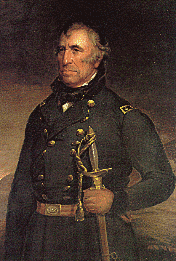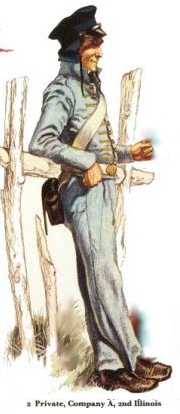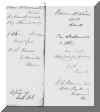With Notes on Isham McCormick
Read John L. McConnel's story on the Illinois 1st Regiment's action at
Buena Vista - click here.
|
As the call for volunteers spread throughout the country, The war was popular with the majority of the people because it helped to alleviate the state’s financial crisis and sparked men’s desire for glory and honor. There was an over abundance of labor, scarcity of money and farmers were unable to sell crops. Most people were engaged in trade and bartered for goods and services. The high rate of unemployment in the state and the increase in immigration was alleviated by the call to arms. Men from all walks of life were brought together creating a volunteer army from laborers, farmers, coopers, lawyers and doctors. Over half of the volunteer troops were foreign-born. According to his discharge
papers, Isham McCormick enlisted on General John Hardin of the First regiment, "Let us not say Taylor and his brave men can whip Mexico without our aid. This is not the language of brave men. Let us have a hand in whipping her. Let our people answer "Aye" in one universal and glorious response." (Illinois State Register May 29, 1846) The first regiment of Illinois Volunteers to form was the 1st Ottawa
Volunteers from St. Clair and Monroe counties. They formed on June 30, 1846
under Colonel John J. Hardin. It was comprised of 877 men divided in to 8
companies. Many other companies sprang up around the state’s trade centers
such as The First, Second and Third Regiments left Alton by way of the Mississippi
river on July 17, 1846 headed to New Orleans. From there they sailed to
Lavaco and marched on to By August of 1846, they reached "Every morning at 3 am the reveille is sounded; every man must be in line for inspection of arms. An hour afterwards, we cook our breakfast, eat, and take down our tents, pack and be on the march. This is the rule for everyday. In September, part of this force which included the First and Second Illinois regiments, began the march south reaching the Rio Grande, San Juan and Santa Rosa. Conditions along the way only grew worse as soldiers died of disease and poor living conditions. Discipline and order among the troops was slowly falling apart as many grew to disrespect Illinois’ Colonel Bissell. Captain Wyatt B. Stapp described the conditions soldiers experienced in a letter home, "Each has a tin cup, a tin plate and a spoon, a table, and a bread board to sit on. A cup of gruel, toast, rice pudding, and goats milk. On the march we simply lie down on the ground with one blanket above and one below." The troops continued marching along the Battle of Buena Vista February 1847The battle of Buena Vista was fought in a narrow mountain pass measuring 1 ˝- 4 miles in width. General Wool arrived there with fewer than 3,000 men. His forces included the First and part of the Second Illinois. Santa Anna arrived with 20,000 men. As General Wool worked his men into position, General Taylor was six miles away defending his supply line from Santa Anna’s forces. General Taylor’s use of muskets and artillery kept the enemy from gaining victory. Colonel Bissell and the 2nd Illinois serving as a division under General Wool at Buena Vista used artillery and cavalry forces to engage the enemy in battle and managed to return fire with dramatic effectiveness. As the Mexican troops retreated, U.S. troops advanced on them. However, the First and Second Illinois and the Second Kentucky were soon forced to pull back into a deep gorge. They were trapped there by the forces of the Mexican army, sustaining heavy losses due to gunfire and lancers It was here that Colonel Hardin and Colonel Clay were lost (Adj. 194). The
units were saved by Colonel Bissell’s quick actions and At length, perceiving the dangers of being entirely surrounded; it
was determined to fall back to a ravine. Colonel Bissell, with his coolness
of ordinary drill, ordered the signal "cease firing" to be made; he
then with the same deliberation gave the command, "Face the rear,
Battalion about face: forward march, " which was executed with the
regularity of veterans to a point beyond the peril of being outflanked.
Again, in obedience to command these brave men halted, faced about, and under
a murderous tempest of bullets from the foe, resumed their well-directed
fire. The conduct of no troops could have been more admirable; and, too,
until that day they had never been under fire, when, within less than half an
hour eighty of their comrades dropped by their sides." Col. Henry L.
Webb and the Pulaski County Riflemen, an independent company from The First and Second Illinois were mustered out of service on June 17, 1847. The Congressional Session of 1848 issues 160 acres of public domain land to
veterans of the Mexican American War. (Isham's Land
Warrant) This offer covered non-commissioned officers, privates, enlisted
(regular and volunteer) and those who were killed or wounded. Pensions were
also granted for widows and orphans. Those soldiers officially discharged
were to receive half a pension. Congress also authorized three months pay for
soldiers to assist them in their financial needs. The State of
|
Section of Battle of Buena Vista depicting Illinois Regimental efforts. Each "man" represents about 10 actual soldiers. Click here to see complete lithograph (click back to return).
"Old Rough and Ready"
Zachary Taylor
Map of Isham's Mexican War Travels based on records. Daguerreotype of Mexican War soldiers
See map of the Battle of Buena Vista
Click here for Alton
Newspaper Article on Battle June 11, 1847 Near the end of their enlistment, the First and Second Illinois Infantry
remained at Headquarters, May 25, 1847 Orders No. 302 The term of service for which the First
and Second Illinois Regiments have engaged to serve the United States has nearly
expired, and they are about to return to their homes. The General Commanding
takes this occasion to express his deep regret at the departure of those who
have been so long under his immediate command, and who have served so well
their country. Few can boast of longer marches, greater
hardships, or more privations, and none of greater gallantry than on the
field of Buena Vista. It was there that the General witnesses with infinite
satisfaction their valor, which gave additional luster to our arms, and
increased glory to our country. To their steadiness and firmness in critical
moment, and when there were five to one against them, and as General Santa
Anna said, "where blood flowed in torrents and their field of battle was
strewed with their dead," we may justly ascribe a large share of the
glorious victory achieved over 20,000 men. A great victory is true; but
obtained at too great a sacrifice. Hardin, Zabriska, McKee, Woodwind, Yell,
Clay, and many others, fell leading their men to the charge. Their names and
gallant deeds will ever be remembered by a grateful people. In taking leave
of these regiment, the general cannot omit to express his admiration of the
conduct and gallant bearing of all, and especially of Cols. Bissell and
Weatherford and their officers, who have on all occasions done honor to
themselves; and heroically sustained the cause of their country in the battle
of Buena Vista. His best wishes will attend them to their homes, where they
will be received with joy and gladness as the pride of their families and of
their States. By Command of Brigadier-General Wool IRWIN M’Dowell, Assistant Adjutant
General. (ADJ XXVIII). |
A total of 116,000 people through out the United States volunteered to serve in the war. Of these, 13,000 died with 11,155 dead from disease and harsh weather conditions. "Dirty camps contaminated food and water, and exposure to severe weather conditions led to amoebic dysentery, diarrhea and yellow fever." Militia units from various stated made up over seventy percent of the United States armed forces during the Mexican war (Hylton). Illinois contributed a total of 6,123 men between June 1, 1846 and January 1, 1848. Eighty-Six of these were killed in action, twelve died of wounds, 160 were wounded and 683 died of illnesses. There were also many cases of desertion that resulted in harsh punishments.
Works Cited
Material above was mostly taken from
www.il.ngb.army.mil/museum/citizen_soldier/mexican/ illinois_in_the_mexican_american.htm
Adjutant General’s report containing the complete Muster-Out Rolls of the Illinois Volunteers who Served in the Mexican War, vol.9.
The Alamo Long Barrack Museum. Compiled by the daughters of the Republic of Texas. Texas: Taylor Publishing Company1986
Cottingham, Carl D, Preston M. Jones and Gary Kent. "General John A. Logan: His Life and Times"
The Diary of the Travels of Augustus Frederic Ehinger Company H, 2nd Regiment 1846-1847. Edited by Charles F. Ward. Rosewell, New Mexico: 1978.
Dupuy, Trevor, Curt Johnson, David L. bongaid. The Harper Encyclopedia of Military Biography. Castle Books: 1996
Hylton, Renee. "Citizen Soldiers: An Illustrated History of the Army National Guard.
Johnson, Col. Carl J. "Wilderness Settlers Mould Illinois National Guard Heritage" A paper submitted to the Illinois National Guard.
Jones, James Pickett. Black Jack: John A. Logan and Southern Illinois in the Civil War Era. Carbondale: Southern Illinois University Press, 1967.
Mauch, Jeffrey. The Education of a Soldier; U.S. Grant in the War with Mexico. Kentucky: American Kestrel Books, 1996
McCartney, Samuel Bigger. Illinois in the Mexican War. Northwestern University, 1939
Personal Memoirs of U.S. Grant. Edited by E.B. Long. New York : A Da Capo Press, 1982.
Santa Anna Leg Museum Collateral Files General Reference, News Clippings, Photographs #1402.
--------------------------------------------------------------------------------
[1] General Winfield Scott 1786-1866. Served in the War of 1812, Seminole
War,





